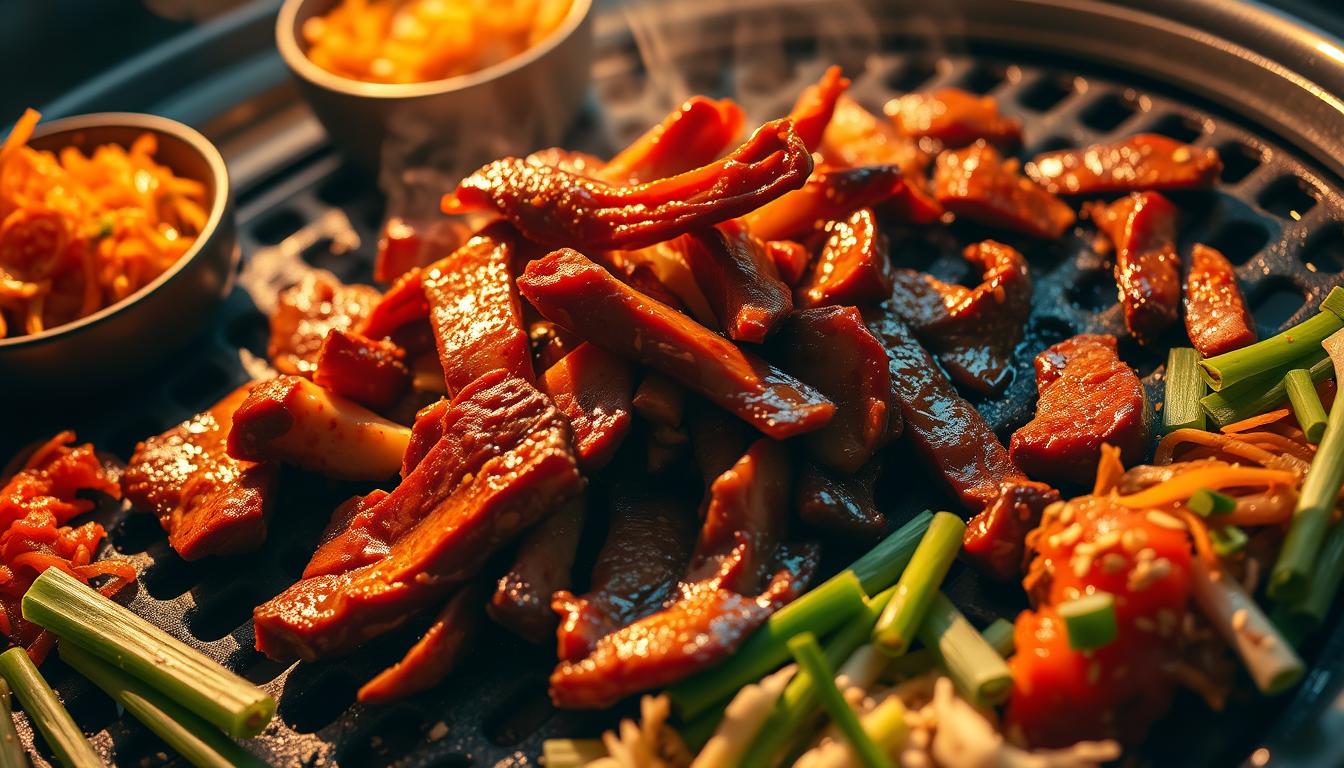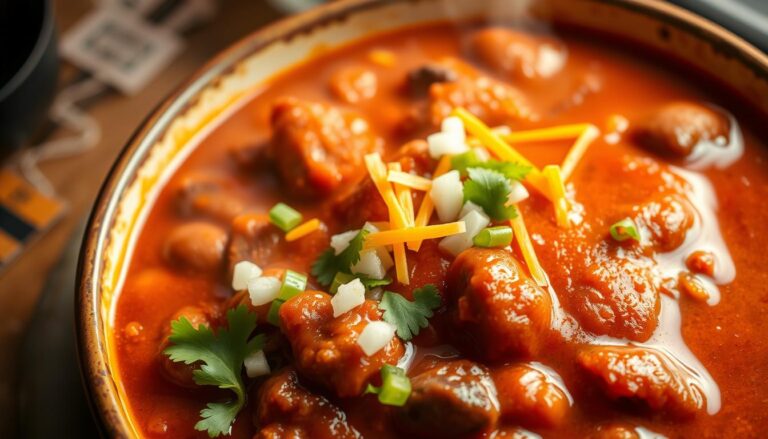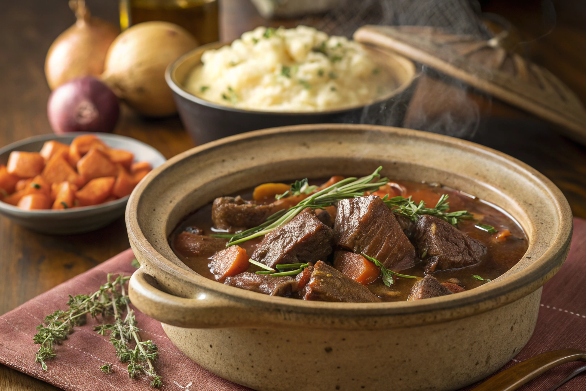If you’re craving a dish that’s both flavorful and easy to prepare, look no further than this classic Korean BBQ creation. Known for its tender meat and rich marinade, it’s a meal that brings bold taste to your table in no time.
With just a handful of ingredients like soy sauce, green onions, and sesame oil, you can create a marinade that infuses every bite with authentic Korean flavors. The best part? It’s ready in under 30 minutes, making it perfect for busy weeknights.
Not only is this dish delicious, but it’s also a balanced meal. Each serving packs a punch of protein and essential nutrients, ensuring you enjoy every bite guilt-free. Whether you’re grilling or using a skillet, the result is always a crowd-pleaser.
Table of Contents
Introduction to Korean BBQ and Bulgogi Flavors
Korean BBQ has long been celebrated for its bold flavors and communal dining experience. At the heart of this tradition lies bulgogi, a dish that translates to “fire meat.” Its name reflects its grilling origins, where thinly sliced meat is cooked over an open flame.
What is Bulgogi?
Bulgogi is a classic Korean dish known for its tender, marinated meat. The marinade typically includes soy sauce, garlic, and sesame oil, which infuse the meat with rich, savory flavors. Historically, bulgogi was prepared using thinly sliced beef, often frozen briefly for easier slicing.
The Appeal of Korean BBQ
What sets Korean BBQ apart is its smoky, savory essence. The marination process is key, as it tenderizes the meat and enhances its flavor. Traditional ingredients like soy sauce and sesame oil create a perfect balance of umami and richness.
Grilling is the preferred method, as it adds a smoky depth to the dish. However, using a skillet is a convenient alternative for home cooks. Whether grilled or pan-seared, the result is always a crowd-pleaser.
| Aspect | Details |
|---|---|
| Marinade | Soy sauce, garlic, sesame oil, sugar |
| Cooking Method | Grill or skillet |
| Flavor Profile | Savory, smoky, umami |
This section serves as your gateway into understanding the culinary technique and cultural significance behind this beloved dish. From its origins to its modern-day appeal, bulgogi continues to captivate food lovers worldwide.
History and Cultural Significance of Bulgogi
Dive into the rich history of a dish that has shaped Korean culinary traditions for centuries. Bulgogi, which translates to “fire meat,” has roots dating back to Korea’s Goguryeo period (37 BCE–668 CE). Originally a royal delicacy, it has evolved into a beloved family favorite.
Traditional Origins and Evolution
During the Joseon Dynasty (1392–1910), beef became more accessible, leading to the development of bulgogi’s signature marinade. Premium cuts like sirloin or rib eye were thinly sliced and marinated in a blend of soy sauce, garlic, and sesame oil. This process not only tenderized the meat but also infused it with rich, savory flavors.
Bulgogi’s cultural significance extends beyond its taste. It is often the centerpiece of family gatherings and celebrations, symbolizing unity and shared joy. Regional variations have also emerged, each adding a unique twist to the dish while preserving its core essence.
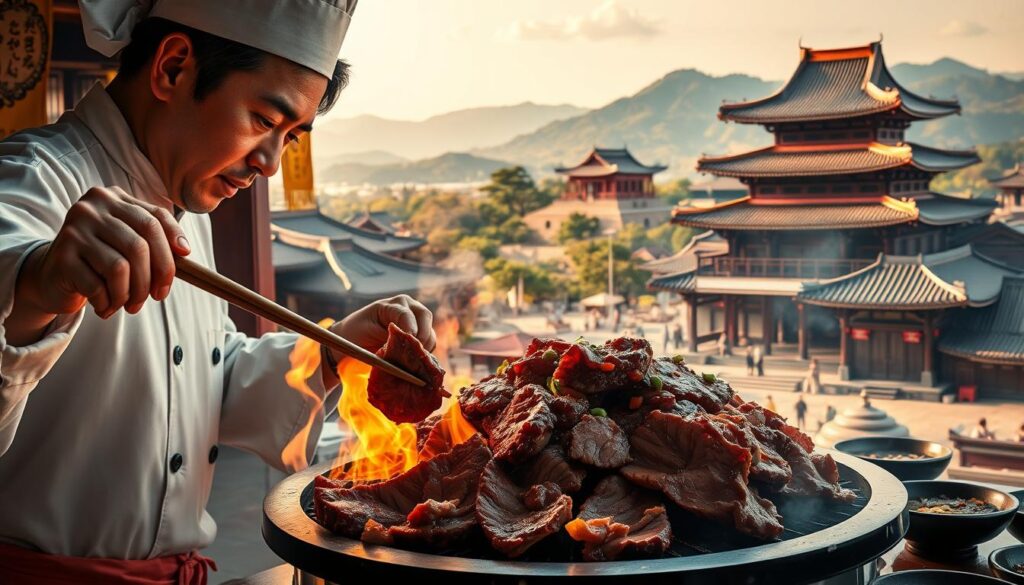
In modern times, bulgogi has gained global popularity, inspiring adaptations like tacos and burgers. Its versatility and deep-rooted history continue to captivate food lovers worldwide. Understanding its past allows you to appreciate the authenticity of each mouthwatering bite.
“Bulgogi is more than a dish; it’s a reflection of Korean heritage and communal spirit.”
| Period | Development |
|---|---|
| Goguryeo Era (37 BCE–668 CE) | Origins as a royal dish |
| Joseon Dynasty (1392–1910) | Introduction of marinade techniques |
| Modern Era | Global adaptations and innovations |
From traditional grilling methods to modern skillet techniques, bulgogi’s evolution mirrors the dynamic nature of Korean cuisine. Its enduring appeal lies in its ability to bring people together, one flavorful bite at a time.
Ingredients and Marinade Mastery
Mastering the art of bulgogi starts with understanding its core ingredients and marinade. The right combination of flavors and techniques ensures a dish that’s both tender and bursting with umami. Let’s break down what makes this marinade so special.
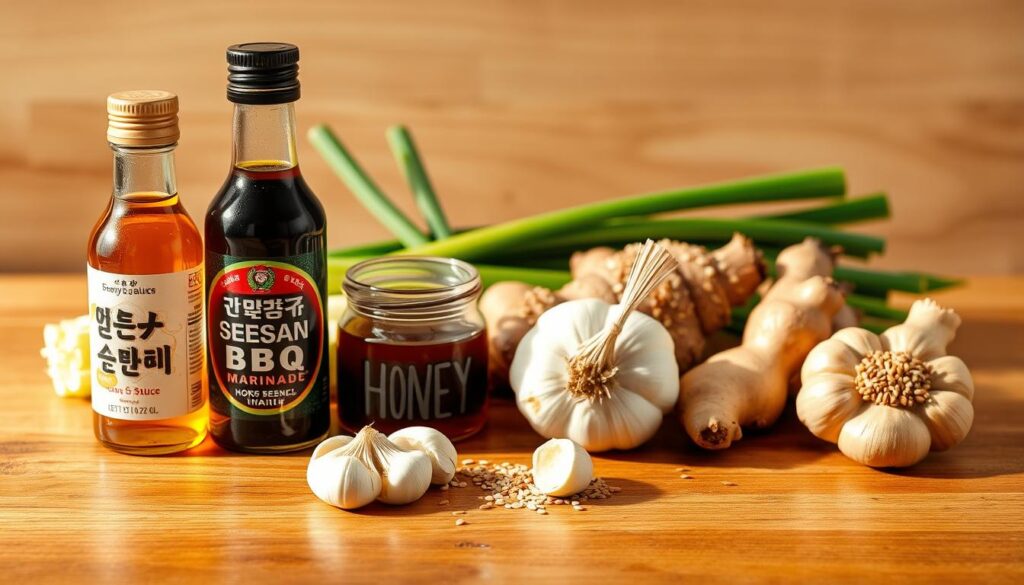
Key Marinade Components
The foundation of a great marinade lies in its balance of savory, sweet, and aromatic elements. Soy sauce provides the salty base, while sugar or honey adds a touch of sweetness. Garlic and ginger bring depth, and sesame oil delivers a nutty finish.
For an authentic twist, consider adding grated Asian pear or apple. These fruits act as natural tenderizers, ensuring the meat stays juicy. A dash of Korean red pepper flakes can introduce a subtle heat, perfect for those who enjoy a bit of spice.
Selecting the Perfect Meat
Choosing the right cut is crucial for achieving the dish’s signature tenderness. Sirloin or rib eye are excellent options, as they are naturally flavorful and easy to slice thinly. Proper slicing techniques, like using kitchen shears, ensure even cooking and better absorption of the marinade.
Marinate the meat for at least 30 minutes, though longer periods enhance the flavor. This step allows the ingredients to work together, creating a harmonious blend that elevates every bite.
By focusing on quality ingredients and precise measurements, you can master the marinade and create a dish that’s both authentic and unforgettable.
Step-by-Step beef bulgogi recipe
Ready to bring bold Korean flavors to your kitchen? This step-by-step guide will walk you through the process of creating a savory meal that’s both simple and satisfying. From marination to cooking, we’ll cover everything you need to know.
Marination Techniques and Timing
Marination is the key to achieving tender and flavorful results. Start by combining soy sauce, sugar, garlic, and sesame oil in a bowl. For an extra touch, add grated Asian pear or apple to naturally tenderize the meat.
Let the mixture sit for at least one hour, though overnight marination enhances the flavors even more. This allows the ingredients to penetrate the meat, ensuring every bite is packed with umami goodness.
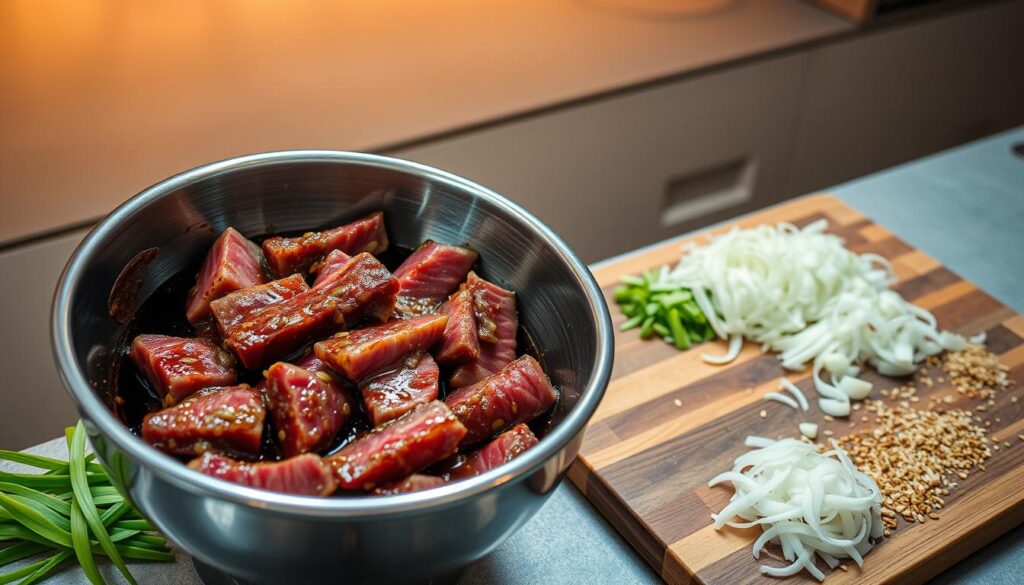
Cooking Methods: Skillet vs. Grill
When it’s time to cook, you have two excellent options: a hot skillet or a grill. A skillet is convenient and perfect for achieving a caramelized finish. Heat it over medium-high heat and cook the meat in batches to avoid overcrowding.
If you prefer a smoky flavor, a grill is the way to go. Char-grilling adds depth and authenticity to the dish. Whichever method you choose, cook the meat for 2-3 minutes per side until it’s caramelized and cooked through.
| Method | Benefits |
|---|---|
| Skillet | Quick, even caramelization, easy to control heat |
| Grill | Smoky flavor, authentic char-grilled finish |
For a final touch, drizzle honey over the meat during the last minute of cooking. This adds a sweet, caramelized glaze that elevates the dish. Serve immediately for the best experience.
Creative Variations and Essential Tips
Exploring new flavors can transform a classic dish into something extraordinary. While the traditional version is always a winner, adding your own twist can make it even more memorable. Here’s how you can experiment with ingredients, marination, and cooking techniques to create a unique version of this beloved meal.
Adding Unique Flavor Twists
One of the easiest ways to personalize your dish is by tweaking the marinade. Instead of the usual Asian pear, try using red apple, kiwi, or pineapple. These fruits not only tenderize the meat but also add a subtle sweetness that complements the savory flavors.
For a spicier kick, add a teaspoon of gochujang or Korean red pepper flakes. If you prefer a milder taste, reduce the garlic or sesame oil slightly. Balancing sweet and savory elements is key to maintaining the dish’s authenticity while making it your own.

Expert Tips for Perfect Results
Marination time plays a crucial role in achieving tender, flavorful results. While 30 minutes is the minimum, letting the meat sit overnight allows the flavors to deepen. If you’re short on time, adding a splash of rice vinegar can speed up the tenderizing process.
When cooking, consider using a grill for a smoky finish or a skillet for quick caramelization. Both methods deliver delicious results, so choose based on your preference and available tools.
| Ingredient | Effect |
|---|---|
| Red Apple | Adds sweetness and tenderizes |
| Kiwi | Enhates tenderness with enzymes |
| Pineapple | Introduces tropical sweetness |
Finally, don’t be afraid to experiment with presentation. Serve your creation in lettuce wraps, over rice, or even as tacos for a fun twist. These small changes can make a big impact, turning a simple meal into a culinary adventure.
Serving Suggestions and Nutritional Overview
Elevate your meal with a perfectly balanced combination of flavors and textures. Whether you’re hosting a dinner party or enjoying a quiet night in, pairing your dish with the right sides can make all the difference. Let’s explore how to create a complete meal that’s both satisfying and nutritious.
Perfect Pairings with Rice and Sides
Steamed rice is a classic accompaniment that complements the savory flavors of this dish. For a refreshing twist, serve it with fresh lettuce leaves, allowing you to create wraps that are both light and flavorful. Traditional Korean side dishes like kimchi or ssamjang add a tangy and spicy kick, enhancing the overall experience.
Don’t forget to include garnishes like sesame seeds and sliced green onions for added texture and visual appeal. These small touches can transform your meal into a restaurant-worthy presentation.
Understanding Nutritional Benefits
This dish is not only delicious but also packed with essential nutrients. A typical serving contains around 226 calories, making it a balanced option for those mindful of their intake. With 10g of fat, 11g of carbs, and 21g of protein, it’s a great way to fuel your body while enjoying authentic flavors.
By incorporating fresh vegetables and lean cuts of meat, you can create a meal that’s both wholesome and satisfying. Whether you’re following a specific diet or simply looking for a healthier option, this dish fits seamlessly into your lifestyle.
“A well-balanced meal is the key to enjoying food without compromising your health.”
With these serving suggestions and nutritional insights, you can create a meal that’s as nourishing as it is delicious. From the first bite to the last, every element works together to deliver a truly memorable dining experience.
Conclusion
Bringing the rich flavors of Korean BBQ to your table has never been easier. This dish combines tradition with innovation, offering a perfect balance of savory and sweet. By focusing on quality ingredients and proper marination, you can achieve tender, flavorful results every time.
Whether you’re grilling or using a skillet, the key lies in the details. Letting the meat marinate for at least 30 minutes ensures it absorbs all the delicious flavors. Experiment with unique twists like adding fruit for natural tenderness or adjusting the spice level to suit your taste.
This recipe is not just about cooking—it’s about creating an experience. Share it with friends, serve it with rice or lettuce wraps, and enjoy the versatility of this classic dish. Ready to explore more? Try this recipe today and discover the endless possibilities of Korean cuisine.
FAQ
What is bulgogi?
Bulgogi is a classic Korean dish made with thinly sliced meat, typically marinated in a savory blend of soy sauce, sugar, sesame oil, and other seasonings. It’s often grilled or cooked in a skillet for a tender, flavorful meal.
What makes Korean BBQ unique?
Korean BBQ stands out for its interactive cooking style and bold flavors. It often features marinated meats like bulgogi, which are grilled at the table and paired with sides like rice, kimchi, and lettuce wraps.
How long should I marinate the meat?
For the best results, marinate the meat for at least 1 hour, though overnight marination enhances the flavor even more. This allows the marinade to fully penetrate and tenderize the slices.
Can I use a different cut of meat?
Yes, while top sirloin is commonly used, you can substitute it with ribeye, flank steak, or other tender cuts. Just ensure the meat is thinly sliced for even cooking.
What’s the difference between cooking in a skillet vs. a grill?
A skillet offers convenience and quick cooking, while a grill adds a smoky char that enhances the dish’s flavor. Both methods work well, so choose based on your preference and equipment.
What are some creative ways to serve bulgogi?
You can serve it with steamed rice, lettuce wraps, or as a filling for tacos. Adding toppings like green onions, toasted sesame seeds, or a drizzle of sesame oil can elevate the dish.
Is bulgogi healthy?
Bulgogi can be part of a balanced diet. It’s high in protein and can be made healthier by reducing the sugar or sodium in the marinade and pairing it with nutrient-rich sides like vegetables.
Can I make this dish ahead of time?
Yes, you can marinate the meat a day in advance and store it in the fridge. This not only saves time but also deepens the flavor for a more delicious result.

